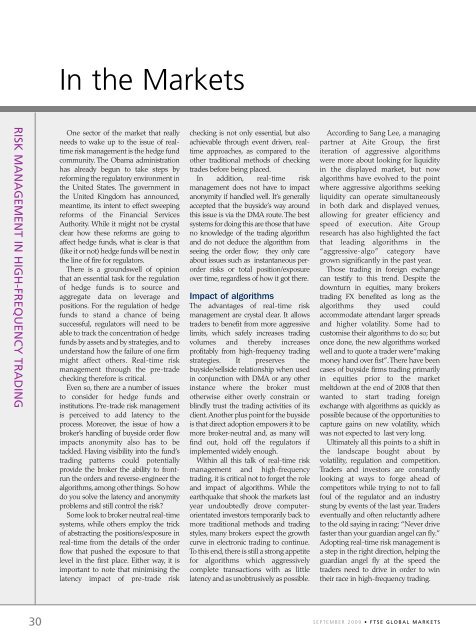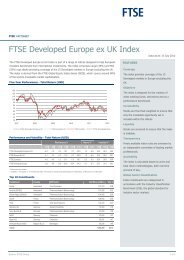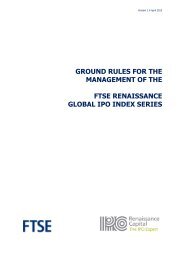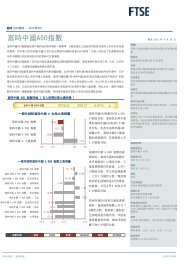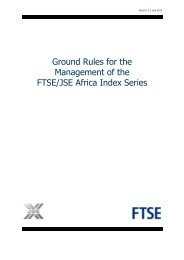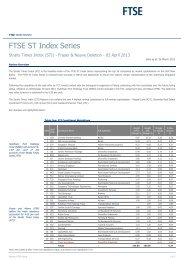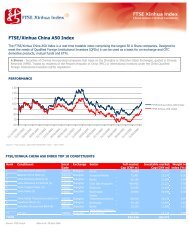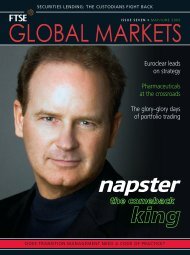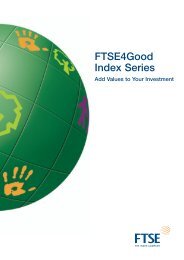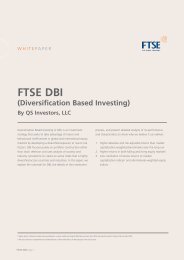Create successful ePaper yourself
Turn your PDF publications into a flip-book with our unique Google optimized e-Paper software.
RISK MANAGEMENT IN HIGH-FREQUENCY TRADING<br />
30<br />
In the Markets<br />
One sector of the market that really<br />
needs to wake up to the issue of realtime<br />
risk management is the hedge fund<br />
community. The Obama administration<br />
has already begun to take steps by<br />
reforming the regulatory environment in<br />
the United States. The government in<br />
the United Kingdom has announced,<br />
meantime, its intent to effect sweeping<br />
reforms of the Financial Services<br />
Authority. While it might not be crystal<br />
clear how these reforms are going to<br />
affect hedge funds, what is clear is that<br />
(like it or not) hedge funds will be next in<br />
the line of fire for regulators.<br />
There is a groundswell of opinion<br />
that an essential task for the regulation<br />
of hedge funds is to source and<br />
aggregate data on leverage and<br />
positions. For the regulation of hedge<br />
funds to stand a chance of being<br />
successful, regulators will need to be<br />
able to track the concentration of hedge<br />
funds by assets and by strategies, and to<br />
understand how the failure of one firm<br />
might affect others. Real-time risk<br />
management through the pre-trade<br />
checking therefore is critical.<br />
Even so, there are a number of issues<br />
to consider for hedge funds and<br />
institutions. Pre-trade risk management<br />
is perceived to add latency to the<br />
process. Moreover, the issue of how a<br />
broker’s handling of buyside order flow<br />
impacts anonymity also has to be<br />
tackled. Having visibility into the fund’s<br />
trading patterns could potentially<br />
provide the broker the ability to frontrun<br />
the orders and reverse-engineer the<br />
algorithms, among other things. So how<br />
do you solve the latency and anonymity<br />
problems and still control the risk?<br />
Some look to broker neutral real-time<br />
systems, while others employ the trick<br />
of abstracting the positions/exposure in<br />
real-time from the details of the order<br />
flow that pushed the exposure to that<br />
level in the first place. Either way, it is<br />
important to note that minimising the<br />
latency impact of pre-trade risk<br />
checking is not only essential, but also<br />
achievable through event driven, realtime<br />
approaches, as compared to the<br />
other traditional methods of checking<br />
trades before being placed.<br />
In addition, real-time risk<br />
management does not have to impact<br />
anonymity if handled well. It’s generally<br />
accepted that the buyside’s way around<br />
this issue is via the DMA route.The best<br />
systems for doing this are those that have<br />
no knowledge of the trading algorithm<br />
and do not deduce the algorithm from<br />
seeing the order flow; they only care<br />
about issues such as instantaneous perorder<br />
risks or total position/exposure<br />
over time, regardless of how it got there.<br />
Impact of algorithms<br />
The advantages of real-time risk<br />
management are crystal clear. It allows<br />
traders to benefit from more aggressive<br />
limits, which safely increases trading<br />
volumes and thereby increases<br />
profitably from high-frequency trading<br />
strategies. It preserves the<br />
buyside/sellside relationship when used<br />
in conjunction with DMA or any other<br />
instance where the broker must<br />
otherwise either overly constrain or<br />
blindly trust the trading activities of its<br />
client.Another plus point for the buyside<br />
is that direct adoption empowers it to be<br />
more broker-neutral and, as many will<br />
find out, hold off the regulators if<br />
implemented widely enough.<br />
Within all this talk of real-time risk<br />
management and high-frequency<br />
trading, it is critical not to forget the role<br />
and impact of algorithms. While the<br />
earthquake that shook the markets last<br />
year undoubtedly drove computerorientated<br />
investors temporarily back to<br />
more traditional methods and trading<br />
styles, many brokers expect the growth<br />
curve in electronic trading to continue.<br />
To this end, there is still a strong appetite<br />
for algorithms which aggressively<br />
complete transactions with as little<br />
latency and as unobtrusively as possible.<br />
According to Sang Lee, a managing<br />
partner at Aite Group, the first<br />
iteration of aggressive algorithms<br />
were more about looking for liquidity<br />
in the displayed market, but now<br />
algorithms have evolved to the point<br />
where aggressive algorithms seeking<br />
liquidity can operate simultaneously<br />
in both dark and displayed venues,<br />
allowing for greater efficiency and<br />
speed of execution. Aite Group<br />
research has also highlighted the fact<br />
that leading algorithms in the<br />
“aggressive-algo” category have<br />
grown significantly in the past year.<br />
Those trading in foreign exchange<br />
can testify to this trend. Despite the<br />
downturn in equities, many brokers<br />
trading FX benefited as long as the<br />
algorithms they used could<br />
accommodate attendant larger spreads<br />
and higher volatility. Some had to<br />
customise their algorithms to do so; but<br />
once done, the new algorithms worked<br />
well and to quote a trader were“making<br />
money hand over fist”.There have been<br />
cases of buyside firms trading primarily<br />
in equities prior to the market<br />
meltdown at the end of 2008 that then<br />
wanted to start trading foreign<br />
exchange with algorithms as quickly as<br />
possible because of the opportunities to<br />
capture gains on new volatility, which<br />
was not expected to last very long.<br />
Ultimately all this points to a shift in<br />
the landscape bought about by<br />
volatility, regulation and competition.<br />
Traders and investors are constantly<br />
looking at ways to forge ahead of<br />
competitors while trying to not to fall<br />
foul of the regulator and an industry<br />
stung by events of the last year. Traders<br />
eventually and often reluctantly adhere<br />
to the old saying in racing: “Never drive<br />
faster than your guardian angel can fly.”<br />
Adopting real-time risk management is<br />
a step in the right direction, helping the<br />
guardian angel fly at the speed the<br />
traders need to drive in order to win<br />
their race in high-frequency trading.<br />
S E P T E M B E R 2 0 0 9 • F T S E G L O B A L M A R K E T S


